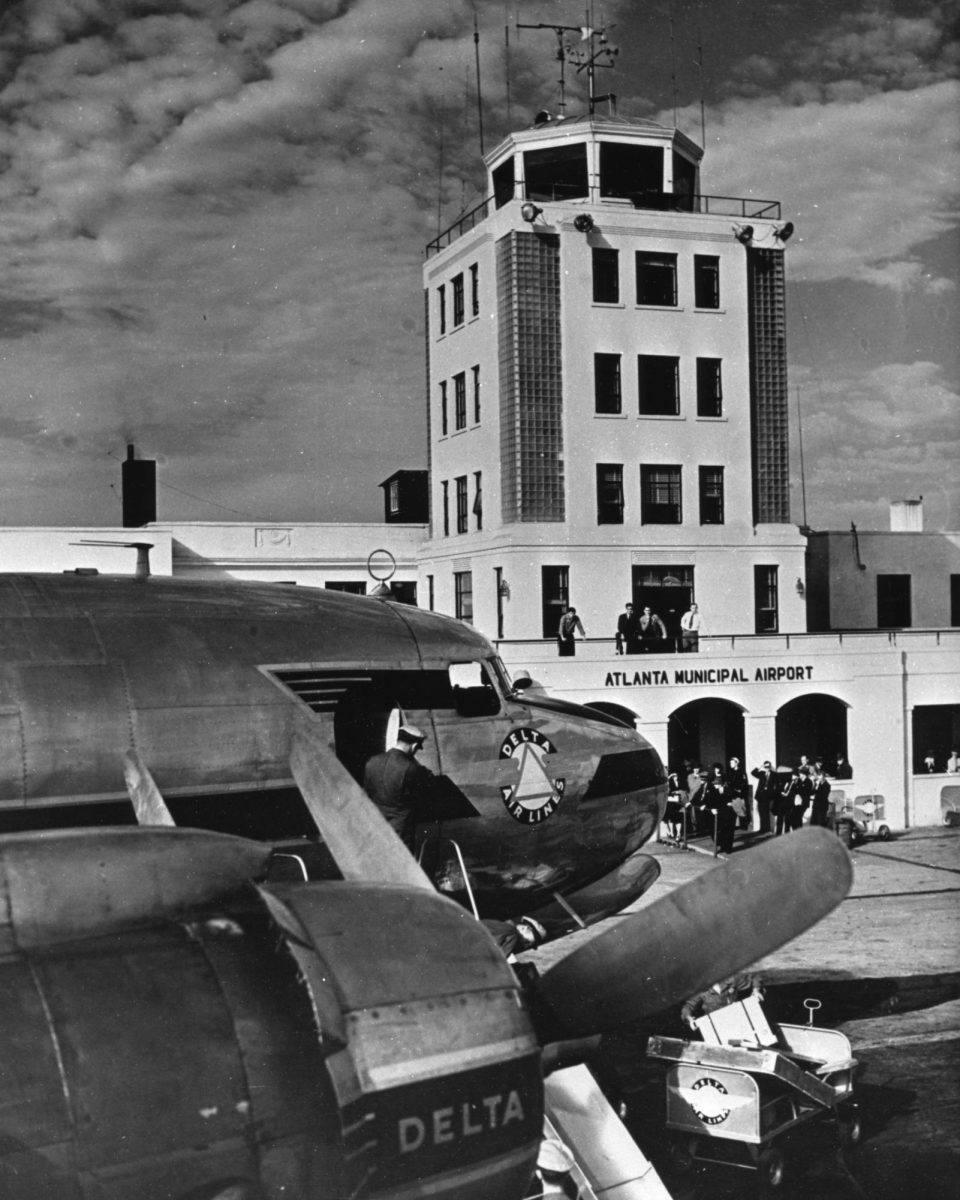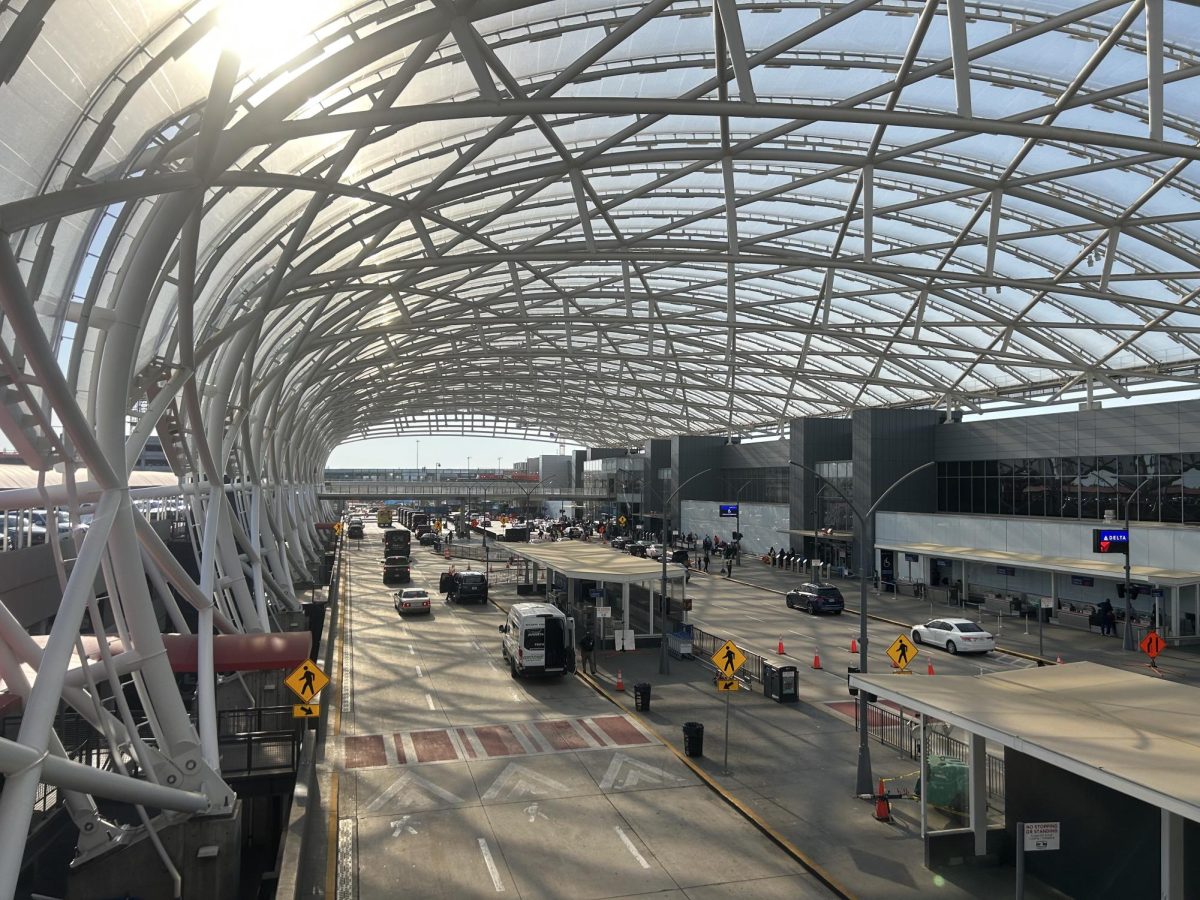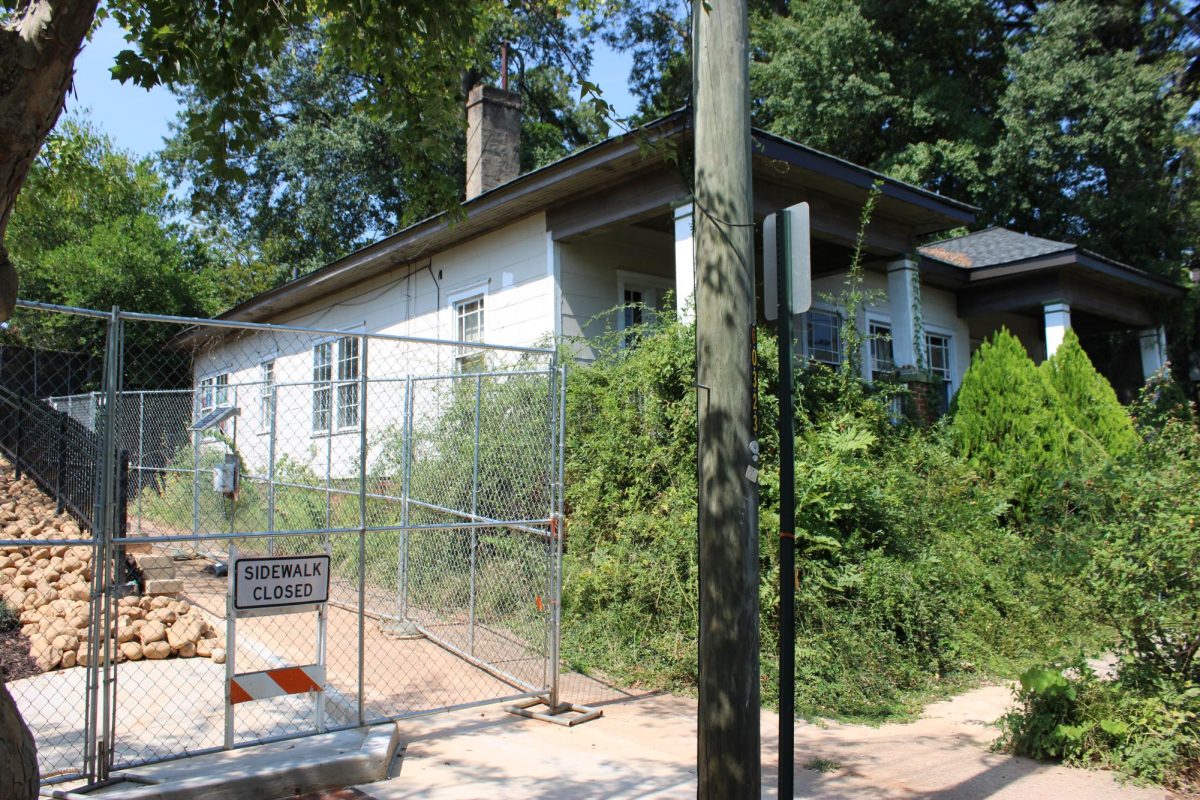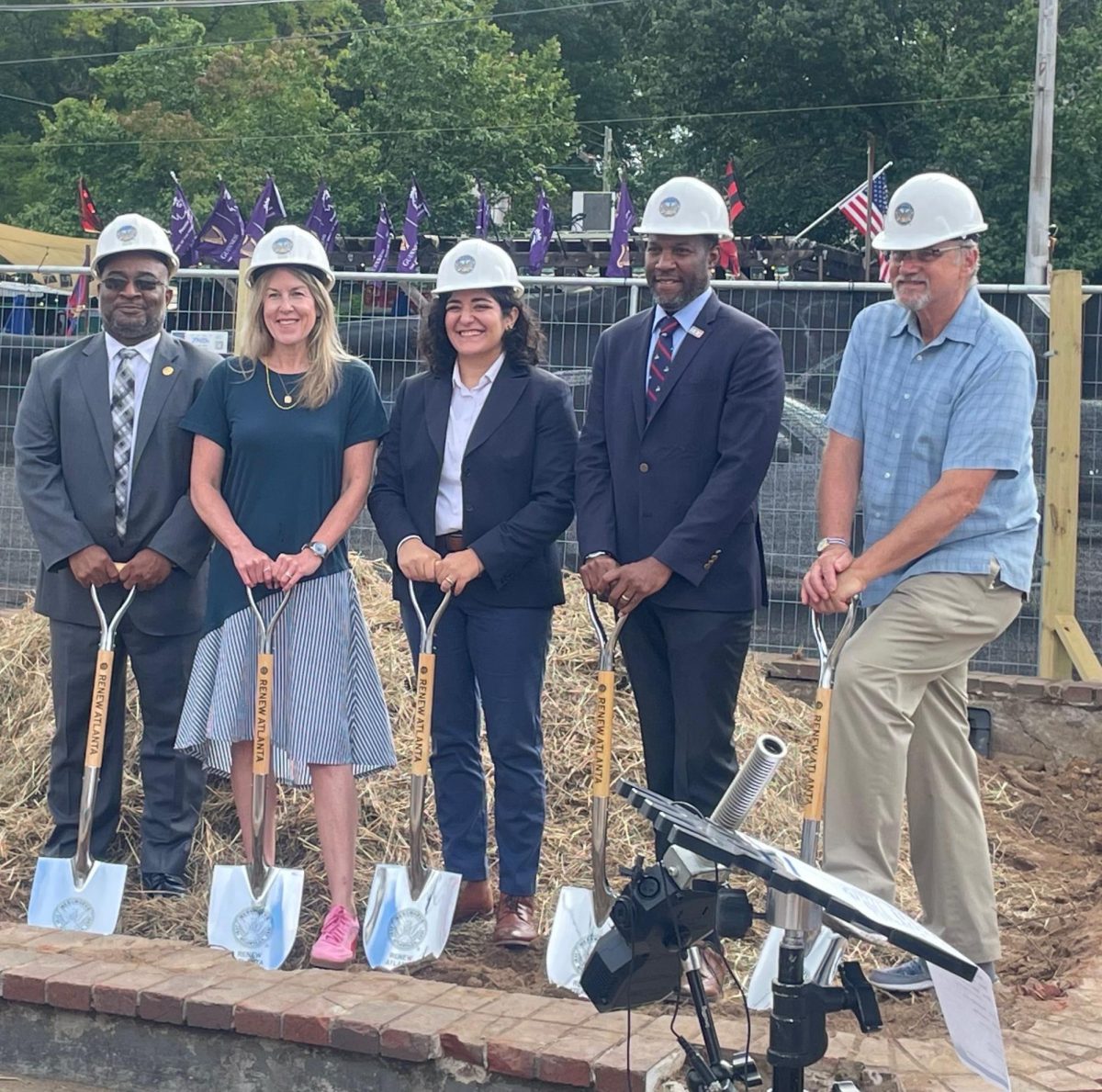Hartsfield-Jackson Atlanta International Airport marks centennial, recognized for legacy of growth, innovation

Twenty twenty five marks the centennial of Georgia’s largest employer and the world’s busiest airport, Hartsfield-Jackson Atlanta International Airport. Over the past 100 years, the airport has played a central role in the city’s growth, infrastructure and identity.
“I like to tell people that everything that happens in society happens or has happened in the airport,” said Jackson McQuigg, Atlanta History Center’s vice president of properties. “If you look at the civil rights movement, all civil rights leaders spread the word, in part, because commercial flights at the airport made it possible … It’s also one of the few things in Atlanta that every person uses and engages with. We might all be of different political persuasions, but sooner or later, you’re going to need to use that airport, therefore, it’s something that everybody thinks and cares about.”
Hartsfield-Jackson consistently ranks as the busiest airport in the world, and carried over 104.7 million passengers in 2024. McQuigg believes Hartsfield-Jackson is the most well-known aspect of Atlanta to both national and international audiences.
“I really think Atlanta is known for many things around the world, but arguably one of the leading things that’s well-known about Atlanta is its airport,” McQuigg said. “I know there are plenty of people that would argue that maybe it’s the R&B scene, or maybe it’s the Civil Rights Movement, or maybe even Atlanta’s recent role as being the Hollywood of the South, but I will maintain that the airport is the thing people know around the world about Atlanta.”
Hartsfield-Jackson generates $34.8 billion annually for the Atlanta area and employs 63,000 people. Shannon James, chief executive officer of the Aerotropolis Atlanta, a public-private organization working to enhance the socioeconomic productivity of the counties surrounding the airport, said the airport is the largest economic driver in Georgia.
“I think Hartsfield Jackson has been the number one vehicle that has shaped the area,” James said. “It’s the anchor of the entire region. I would say Hartsfield-Jackson has been the catalyst for economic growth and impact for the area in South Fulton and Clayton County. So whether that’s jobs, industry, [or] housing infrastructure, the airport has been the driver.”
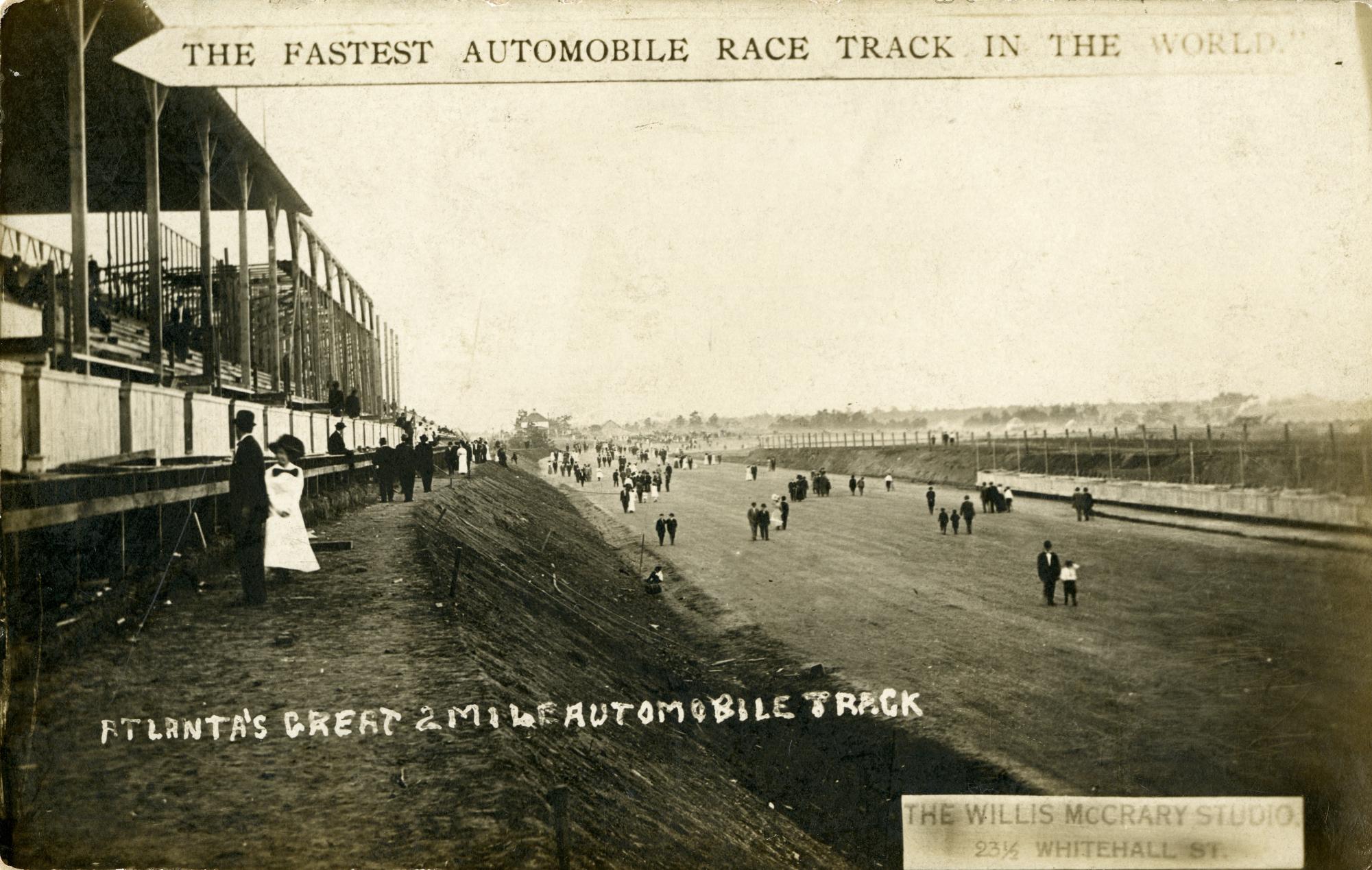
A century ago, before what became Hartsfield-Jackson Atlanta International Airport, stood a race track envisioned to become the largest in the country by Asa Candler Jr., son of Coca-Cola magnate Asa Candler Sr.
“Asa Candler Jr. was an automobile aficionado and came up with the idea of establishing a race track near Atlanta after Indianapolis announced plans to build the world’s greatest raceway in early 1909,” David Henderson, author of “Sunshine Skies: Historic Commuter Airlines of Florida and Georgia,” said. “Using his father’s Coca-Cola fortune, Candler Jr. and businessman Ed Durant quietly began buying property in the Hapeville area with the intention of using the site for their race track.”
Sara Butler, author of “Fortune and Folly: The Weird and Wonderful Life of the South’s Most Eccentric Millionaire,” said Candler Jr.’s venture failed due to the remote location of the race track from the city and his poor marketing efforts.
“[The distance from Candler Field to Downtown] would have been a much longer journey on unpaved roads because people didn’t have an automobile,” Butler said. “So, you’re either going in a horse-drawn buggy, or at some point, they built some mass transit out there, but it was overly expensive. He spent so much money to build it that it wasn’t feasible for any degree of popularity to have made it profitable. And so that very first year, he had a massive crowd that turned out for the inaugural races; it was a huge event. He had the most famous drivers, the best drivers. He made national news. It was huge, and he still didn’t make enough money to even pay the vendors that had helped to build it.”
The track’s financial struggles led to foreclosure, and Candler Sr. took ownership of the land. However, the land soon found a new purpose when two local pilots, Beeler Blevins and Doug Davis, approached the Candlers to use the land to offer flying lessons and test the idea of air mail in the region. The land became known as Candler Field and quickly became popular.
“[Blevins and Davis] had this vision that you could use airplanes and air travel to deliver mail faster than it could be delivered by land, so they wanted to be able to test out air mail,” Butler said. “It gained traction, and then the rich guys, they moved on from owning cars, and they started owning private planes in the late teens and the early 20’s. More and more people wanted to park their planes out there. More and more people wanted to learn to fly out there, and so Doug Davis and Beeler Blevins built hangers out there.”
As aviation gained popularity, Candler Field began hosting air shows that attracted public attention, including that of William Hartsfield, whom the airport is named after, along with Maynard Jackson. Harvey Newman, Georgia State University Professor Emeritus in the Department of Public Management and Policy, said Hartsfield, who was a city Alderman at the time, worked tirelessly to secure city investment in Candler Field and eventually pushed for its purchase as Atlanta’s official airport.
“He’d always been interested in aviation, and he believed that Atlanta would really benefit from having this airport,” Newman said. “The city’s finances were not in a good place at that time. We were sort of financially going through a little bit of a recession. But he campaigned and campaigned and campaigned … and the city rallied the money because of him and bought the land. That’s why it’s called Hartsfield-Jackson airport. I believe it was Mayor (Walter) Sims who was in office at that time, and he reflected back on it and said it was one of the most important decisions the city had ever made.”
Hartsfield went on to become Atlanta’s mayor in 1937 and continued to advocate for Atlanta as an aviation hub. Newman said one of his most significant accomplishments was ensuring that the city was chosen over Birmingham for a key airmail route, which boosted the airport’s growth and economic viability.
“[Hartsfield] decided that the city would show the Federal Aviation Administration (FAA) that they were the logical city for this airmail route to pass through rather than Birmingham, and so when the FAA representative landed in Atlanta, they did a motorcade from the airport to downtown,” Newman said. “He was put up in the finest hotel in town and wined and dined, and when he left, they knew Atlanta was going to get the air mail route instead of Birmingham. So, the hospitality that they had shown the FAA administrator helped pave the way for Atlanta getting that air mail route in Atlanta’s airport. It’s still very much the case that Atlanta has a major international airport, and Birmingham was very much left in the dark.”
In the airport’s early days, the area struggled with weather conditions. In 1929, the Atlanta Journal-Constitution described Candler Field as “a bane in the existence of all pilots who must visit the field,” resulting in “broken wing tips, shattered propellers and smashed landing gears.”
“I think one of the big challenges of the early years was being able to maintain the field and provide runways long enough for larger and faster planes that were being developed,” Henderson said. “The big problem was that the dirt runways had ruts, gullies and washed-out areas. Every time it rained, it got worse.”
Despite the physical challenges and public skepticism surrounding air travel, McQuigg said many individuals saw past the condition of the fields and the uncertain future of aviation.
“The saying at the time was ‘move fast and break things,’” McQuigg said. “I think there’s an element of that to aviation. It’s about doing some pretty daring things and being really visionary at a time when railroads were the dominant form of transportation; the planes were just seen as a folly, as an amusement, and to see how they could one day link the country and the world — it must have sounded like a far fetched tale. People in Atlanta talking that way, I think that’s pretty remarkable.”
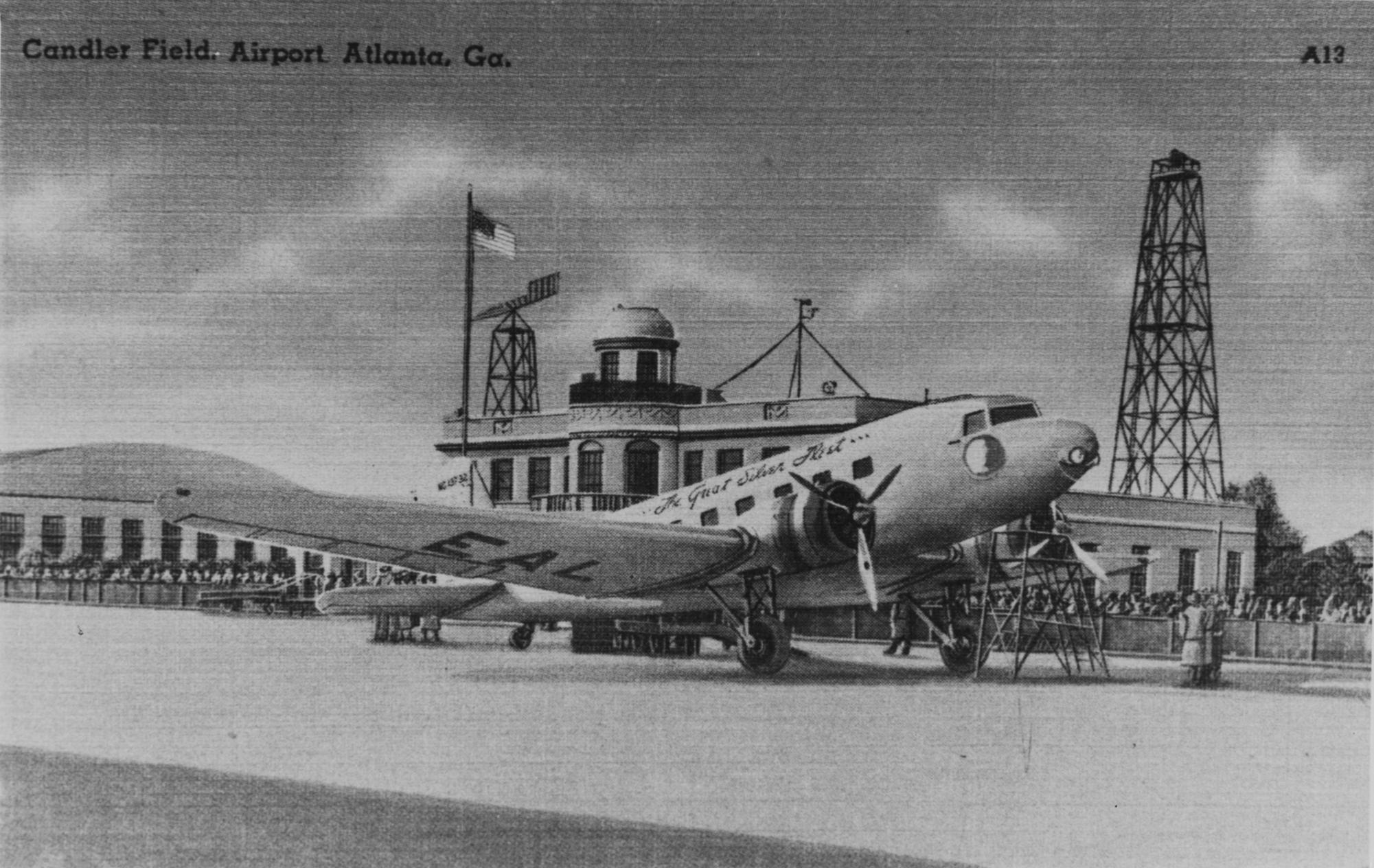
As the Atlanta Municipal Airport (Hartsfield-Jackson’s original name) began establishing itself as a commercial airport, the city took strides to promote itself to airlines and air mail routes, leveraging its geographic location, leadership and key business partnerships, enabling its area to expand from its initial 287 acres to 4,700 acres today.
“It was Atlanta promoting itself as a great place for an airport,” McQuigg said. “There was a very active effort in the 1920’s to get airmail contracts in Atlanta, and make Atlanta the Air Mail crossroads of the South … It’s just mind boggling to think that for 100 years, leadership in Atlanta has promoted aviation.”
Eastern Airlines first established a hub in Atlanta in 1930, helping to cement the city’s position as a major aviation hub. A decade later, Delta Air Lines moved its headquarters to Atlanta, paving the way for the airport to become the epicenter for two major airlines.
“[Delta] came back to stay in 1934, and of course, that had [an] epic influence on Atlanta airport,” McQuigg said. “Delta moved its headquarters to Atlanta in 1941 as a much smaller company. And with Delta, we’ve got C.E. Woolman, who was the head of that company and the visionary behind Delta, and where would we be without Delta today?”
McQuigg said the airport, serving a principal hub for both Eastern and Delta, as well as Delta’s headquarters, created friendly competition between the airlines, which helped bolster the economic productivity of the airport.
“For many years, throughout the 70s and 80s, there was a friendly competition between Eastern and Delta to see who could load more passengers at the airport because it was a huge hub for both of them,” McQuigg said. “I remember as a kid, or as recently as the 1990’s, you flew into Atlanta, and there would be both Delta and Eastern planes everywhere. The airport was jam-packed, and you could get to all sorts of places on either Delta or an Eastern flight. In fact, it was Eastern, in 1971, that gave Atlanta its first non-stop international flight.”
The growth of both Delta Air Lines and Eastern Airlines, along with Atlanta’s increasing role as a business and logistics center, helped drive the airport’s expansion. As early as 1942, the Atlanta airport was named the nation’s busiest airport.
“Atlanta is centrally located in the Southeast and is a perfect connecting point for traffic going in any direction to or from the south,” Henderson said. “This was true with the railroads and is true today with the expressways. They all converge in Atlanta. The airport quickly became a transfer hub where Eastern Air’s north and south flights between New York, the Midwest and Florida connected with Delta’s east and west flights between the Carolinas and Texas. That has always been the key to ATL’s success. It’s the world’s largest connecting hub.”
With the growing popularity of passenger flights at the airport, one of Hartsfield’s final decisions as mayor of Atlanta was to create an airport terminal that would expand access to more passengers. Newman said within the first year, the terminal quickly surpassed the number of passengers the terminal was designed to serve.
“By 1961, we were able to move into the new airport terminal,” Newman said. “The airport was designed to serve six million passengers a year, which would’ve made it the second largest airport in the country. And taking advantage of having two major airlines with their hub here the growth of passengers and planes coming into the airport exceeded six million and its first year of operation of the new terminal and facilities, and so very quickly, we began to outgrow the old and the new buildings that Hartsfield had helped engineer, and so, by the early 1970s, there was already a good bit of planning as to what the future would be of Atlanta’s airport.”
One of the most transformative periods for Atlanta’s airport came under the leadership of Mayor Maynard Jackson. Newman said in 1970, the city underwent a massive demographic change and for the first time in history, Atlanta became a majority African American city, and as the city’s first African American mayor, Jackson sought to promote minority economic inclusion in public works projects.
“Maynard Jackson was elected as mayor in 1973,” Newman said. “He was an aviation fan, a promoter, much like Hartsfield was, and he also did something extremely important –– as an African American, he wanted to see more minority participation at the airport, particularly as the 1980 terminal had been designed within the early stages of design. So, he expanded the role of minority participation in public works projects in Atlanta, and it’s well known that the airport launched a lot of careers.”
In the 1970s, there was debate across Atlanta about whether or not to create a second airport in light of the airport’s rapid growth. Newman said Jackson’s leadership played a pivotal role in expanding the existing airport rather than constructing a second one and ensuring economic opportunities remained concentrated in Atlanta’s southside communities.
“When Maynard Jackson was expanding, he decided the old terminal that Hartsfield had built in the 1950’s was outgrown and needed to be replaced,” Newman said. “There was debate over a second airport or expanding the existing airport, and Maynard Jackson, for a variety of reasons, strongly supported keeping the existing airport location. One advantage was that it’s only 7 miles from downtown Atlanta, so cab rides and transportation are much cheaper than in many other cities where the airport is so far out. There was also a racial dimension to it, and that was as the first African-American mayor of the city, Mayor Jackson was interested in expanding economic opportunity for residents of the southside, who generally lagged behind economic development and investment … and [the airport] continues to be a very important source of employment for residents of southside Atlanta.”
Newman said Maynard established a strong partnership between the city and business leaders through the Atlanta Action Forum, where both African American and white business leaders would meet with city officials once a month to discuss problems and solve issues regarding the city’s future, including expanding economic opportunities through the airport.
“They agreed to support the expansion of the existing Atlanta airport and went forward with unity with Maynard on this subject,” Newman said. “Maynard was interested in giving opportunities in this new airport construction because when he took office in 1974, less than 1% of all contracts went to minority business firms, and he said, as part of the expansion of the airport, at least 25% of all contracts for everything at the airport from design to construction to engineering, everything was to be awarded to women or black owned businesses.”
When Andrew Young was elected in 1982, he continued Jackson’s legacy of expanding economic access to minorities by increasing the required percentage of minority contracts in the airport to 35%. McQuigg said Young made great strides to further expand the airport during his terms as mayor.
“He was equally a promoter of the airport for the entire time that he was involved with the city, and he was out there trying to get more international flights successfully,” McQuigg said. “He was also a major player in getting the Olympics to Atlanta. And where would the Olympics be without a major international airport?”
Henderson believes the city’s leadership throughout the past century has been integral to the airport’s growth.
“The idea of using Atlanta as a connecting point between different cities has always been the driving force in the airport’s growth,” Henderson said. “The city’s willingness and ability to provide the facilities to accommodate that growth has been the key to making ATL (Hartsfield-Jackson’s official call letters) the busiest airport in the world.”

Hartsfield-Jackson is an economic engine for the region, and has driven job creation, business opportunities, and industry growth. As the world’s busiest airport, it plays a critical role in shaping Atlanta’s economy.
James said the airport’s economic ripple effect goes far beyond the airport itself, creating opportunities for small businesses, entrepreneurs and major industries.
“From a logistics perspective, advanced manufacturing, biolife science are industries in Atlanta because of the infrastructure,” James said. “The highways, byways and the airport are very strong in our region. Biolife science has a huge presence because of the time in which it takes to produce a product to then be cargo via flight or truck … Georgia has a huge movie film presence, and Hartsfield-Jackson is the driver, people are flying into Hartsfield. And so, we have several movie studios, whether it’s Tyler Perry or Atlanta metro studios, I could go on and on. We’ve got several movie, film studios in the area. There’s also a lot of food and agri business in the area because of the proximity to the airport, and also our high rate of infrastructure with ingress egress, whether it’s I-75, I-85, I-20, we’ve got a lot of connection points.”
James said the airport inherently has functioned as an economic multiplier to create more opportunities around it as the largest employer in the state.
“The airport itself is a huge employer, and then the airport has several different partners, affiliates, who work with the airport directly and indirectly, that have created opportunities,” James said. “So, you’ve got airlines, you’ve got different providers, like transportation connectivity, you’ve got service providers, you’ve got really a multiple domino effect because Hartsfield’s economic impact has not only been a job creator, but also a source for small businesses and entrepreneurs. There are a ton of entrepreneurs who work with the airport and work with the airlines, who also are job creators from a small business perspective.“
Henderson said the airport has not only served to connect Atlanta to international communities, but to also provide an outlet for small towns in the South.
“Because ATL is the world’s largest connecting hub, many smaller cities across the South rely on connecting flights through Atlanta for their air service,” Henderson said. “An old saying says, ‘Whether you go to heaven or hell, you have to change planes in Atlanta.’”
However, the airport’s expansion has not come without costs, particularly for surrounding communities. Newman said through the process of expanding the airport’s runways and facilities, neighborhoods and communities have been displaced, including a small town known as Mountain View that was effectively destroyed to pave way for the airport.
“[Mountain View] was this little community that had been there for a long time, and they were fiercely proud of their location, even though they were kind of near the end of the runway and the expanded runway would kind of take them out,” Newman said. “So, there was a big human cry over what to do with Mountain View. There weren’t very many people living in Mountain View by that time; it was a horrible place to live in because of the night and day rumblings of airplanes taking off and landing, so [the city of Atlanta] secured the money to buy the land and bulldozed all houses, so it is effectively obliterated.”
James said the airport’s presence has made development more complex in nearby areas. Strict zoning laws, noise regulations and infrastructure requirements have slowed the pace of growth and discouraged investment.
“The noise from the airport is a challenge, so development is slower in our region because there are so many requirements when you’ve got an airport, and so that ultimately has slowed the pace of growth because it costs more to develop in our area because of the airport,” James said. “It has really created somewhat of an inefficiency for our region to grow at the pace in which other areas are growing. The airport has restrictions in certain areas that have created challenges for development, as well. It’s hard for developers or investors to navigate, so they oftentimes just leave the area and go somewhere else and develop.”
The development of the airport has jeopardized the flow of the Flint River, reducing access to water for communities residing by the river downstream.
“It flows through the airport in an underground pipe largely and then comes out at the other end,” McQuigg said. “In other words, it’s been treated as a problem at the airport, and yet the airport is more or less at the origin of the river, which downstate in places like Albany, it defines recreation, and it winds up in the Gulf of Mexico, the water there. And until the past decade or so, it was not terribly well protected. The airport was not terribly conscious of it, and now they’re focused on being good stewards of it.”
Recognizing these issues, airport officials have implemented sustainability initiatives to mitigate past damage.
“From an environmental perspective, I have to give the airport kudos,” James said. “They’ve worked their butts off, especially around sustainability, to help mitigate old practices under old leadership. Now that they’ve gotten newer leadership, the airport has been more conscientious about water sewer power that’s being generated in the area, they’ve been more conscientious about their relationship and their approach for working and being proactive around mitigating risk with the Flint River. But it’s a work in progress, the airport is not perfect. Our region is not perfect, but I will say they’re working towards mitigating those risks that have been associated with the Flint River.”
James said collaboration between the airport, Clayton County and the Atlanta Regional Commission led to recent approval of federal funding for environmental improvements, a major step in addressing the issues with the Flint River.
“The region was approved for $64.9 million of federal funding,” James said. “It was called the Reconnecting Communities grant. It was approved under the infrastructure bill of the Biden administration via the U.S. Department of Transportation. That grant was intended to help us create multi modal activities so that people can actually walk or bike in the area along the Flint River. It also created funding to improve soil mitigations and water runoff because there’s some flooding issues south of the airport. Well, under the Trump administration, that funding was basically frozen. So, unless the new administration approves our application, then all that hard work, working together, will go to waste. And so we really hope that doesn’t happen.”

As global aviation continues to evolve, the competition to remain the world’s busiest airport is becoming increasingly difficult. McQuigg said rapid expansion in Asia, where economies are growing and infrastructure is improving, is leading to a surge in air travel.
“Looking forward, it will increasingly be harder for Atlanta’s airport to be the busiest airport in the world,” McQuigg said. “Flying in the United States was once the province of the wealthy; you had to have a lot of money, particularly before deregulation in 1978. And [airline deregulation and expansion] is happening in Asia right now, and it will undoubtedly happen in other parts of the world. And as that happens, places that inherently have larger populations are going to try to take Atlanta’s world’s busiest title from it. So, in order to keep up with that, we’re going to have to continue to expand our airport and make sure that it is kept up to date. “
James believes the airport’s influence extends beyond travel and shapes Atlanta’s ability to attract major global events and investment.
“The world meets in Atlanta; this is the center,” James said. “It is no mistake that FIFA 2026 is coming to the land largely because of Hartsfield-Jackson; it’s no surprise that we’re the recipients of Super Bowls, and the NCAA finals — we’re attracting all of these big events … It’s critical that we continue to wrap our arms around and support the airport, because so goes the airport, so goes Metro Atlanta.And if people don’t realize that, then they haven’t been paying attention because Hartsfield Jackson is driving industry, not just in our region, but all over the city of Atlanta, Gwinnett County, Cobb County, Henry County. Hartsfield-Jackson is at the center of the growth of this area, so if the airport declines, so will Atlanta.”
McQuigg believes the legacy of Hartsfield-Jackson speaks to Atlanta’s broader ambitions as a community.
“The lasting legacy of the airport is the legacy of Atlanta, which is that if you can dream it, you can do it,” McQuigg said. “I don’t think that anybody 100 years ago could have predicted that our airport would ever be the economic engine. These were not people from New York or Philadelphia, one of the established mainline cities of the Northeast that made this happen. These are people from Georgia. They’re people of many colors. It’s men and women who made our airport what it is today. And you know, Chicago, New York, Philadelphia, Boston, they don’t have the hubs, they don’t have the world’s busiest airline we do in Atlanta. I think that really speaks volumes.”




